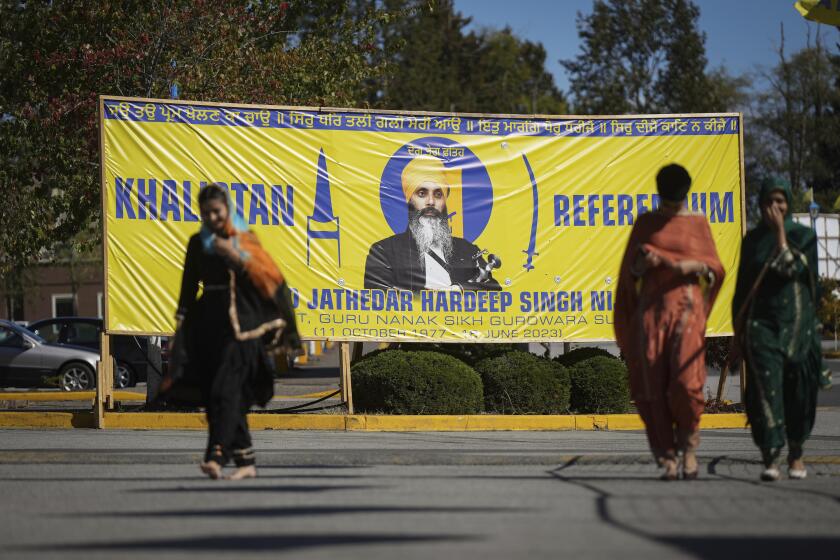N. Korea Nuclear Deal at Risk, U.S. Fears
Clinton administration officials say a lack of money could soon halt work on a nuclear power plant under construction in North Korea that is the centerpiece of the 4-year-old deal to stop that country’s nuclear weapons program.
Despite a series of meetings over the past several months, the United States, Japan and South Korea have been unable to work out payment for the $5.1-billion project. If it is not resolved, the financial wrangling could call into question the viability of the reactor project--and, with it, the entire 1994 agreement in which North Korea agreed to place under international safeguards some material it could use to produce nuclear bombs.
According to U.S. officials, the accord calls for South Korea to pay about 70%, Japan about 20% and assorted countries the remainder of the costs of a nuclear plant that would supply power for energy-starved North Korea. But the governments in Seoul and Tokyo, both struggling to cope with the financial crisis afflicting Asia, are now having trouble winning parliamentary approval for their shares of the money.
Work is underway at Kumho on North Korea’s northeast coast to clear a site for the project. But the groundwork will soon have to be delayed because the money to pay for it is running out. “If the money isn’t there, there won’t be any earth moved,” a senior U.S. official said.
In Washington, some Republican critics who originally questioned the wisdom of the deal with North Korea are now calling for the agreement to be scuttled. Administration officials insist that the reactor project will go forward and describe the infighting over money as a temporary setback. “It isn’t a crisis,” said the senior U.S. official.
But he made no effort to hide the U.S. irritation at Japan and South Korea for not coming up with their shares. “The problem here is [South] Korean and Japanese mismanagement of an obligation they agreed to incur.” Authorities in Seoul and Tokyo, he said, did not start until very recently the job of selling the reactor project to their parliaments. “That wasn’t smart,” he said.
South Korea’s new president, Kim Dae Jung, promised in his inauguration speech six weeks ago that Seoul will honor the commitments it made to help pay for the North Korean power plant. But his party does not control the National Assembly, which has been balking at appropriating the money in the midst of South Korea’s financial crisis.
The idea behind the 1994 deal was that North Korea would get a nuclear power plant to replace the old facility that U.S. officials said was being used as part of a nuclear weapons program. The new plant, which will employ light-water technology, produces a grade of plutonium that cannot be turned into weapons-grade fuel. The nuclear reactors that North Korea agreed in 1994 to dismantle used gas-graphite technology that can be used to make the fuel for a bomb.
As the funding problems have become increasingly evident, critics of the original deal have suggested that North Korea doesn’t need and shouldn’t get a nuclear reactor. “North Korea desperately needs smaller projects, to bring food, shelter and clothing to an economy rapidly sinking back into the Stone Age,” James Lilley, a former U.S. ambassador to South Korea, recently wrote. “It needs small, coal-fired power plants that fit its antiquated electric grid, not massive modern reactors.”
But the administration rejects these suggestions as unworkable. “Not in a million years” would North Korea agree to rewrite the deal it negotiated with the United States, one U.S. official said.
Administration officials now suggest the possibility that South Korea could contribute a lesser share now, then pay a larger sum in later years when its economy rebounds.
The obligation for Seoul to pay 70% of the cost applies over the 10 years it will take to build the plant, not for each year, the senior State Department official noted. He estimated that the sum needed to continue construction in 1998 is about $200 million, a relatively small share of the overall cost.
In persuading South Korea and Japan to put up the money for the project, the administration confronts an awkward problem of its own making: President Clinton four years ago seemed to suggest that the United States might pick up the cost as a last resort if the other governments failed to do so.
In a personal letter to Kim Jong Il, the late North Korean leader, in October 1994, Clinton pledged to “use the full powers of my office,” subject to congressional approval, to ensure that North Korea would get its nuclear plant. That letter, and the continuing economic problems in Seoul and Tokyo, raise the question of whether the administration may ask the U.S. Congress for an appropriation for the North Korea project.
“We’re going to be hit up for more money,” one congressional source predicted, though others on Capitol Hill said it is unlikely Congress would make up what South Korea and Japan are not paying.
U.S. taxpayers already have been footing the cost of heavy fuel oil being shipped to North Korea under another part of the 1994 deal. The total cost of these shipments will be about $400 million over the lifetime of the agreement.
The organization responsible for constructing the North Korean plant is the Korean Energy Development Organization, a consortium of American, South Korean and Japanese officials. KEDO officials met in New York City in February and again last month to try to divide up the costs for the North Korean venture. But both times, the talks ended without agreement.
More to Read
Start your day right
Sign up for Essential California for news, features and recommendations from the L.A. Times and beyond in your inbox six days a week.
You may occasionally receive promotional content from the Los Angeles Times.






